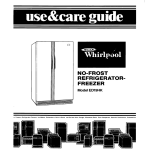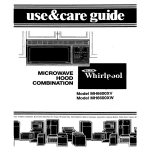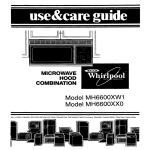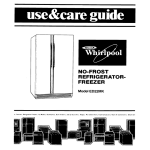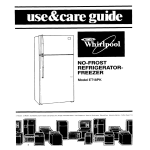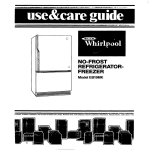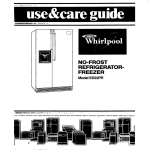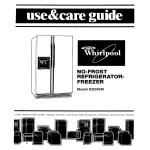Download NO-FROST REFRIGERATOR
Transcript
) &&!Qh? SERIES 1 0 NO-FROST REFRIGERATORFREEZER Model ETl4EP ~e+?~~~.“~ i r -m :.q, ~-i~:r~~4 rs. Freezers. Refrigerator-Freezers. II ;*,::a;. :g&$%+ /: zs9(” +r.ui,u.$.“‘** c.^ -. 4 Ice Makers, Dishwashers, Bmlt-In Ovens and Surface Units, Ranges. Microwave Ovens, Trash Compactors, Room Air Conditioners. flehumldifi Please read this Use and Care Guide before you do anything else... This booklet tells you how to start your refrigerator, clean It, move shelves and adjust controls. It even tells you what new sounds to expect from your refrigerator. Treat your new refrigerator with care. Use it only to do what home refrigerators are designed to do. Parts and features Ice Cube TraysAir Control - - Freezer Shelf - Utility Compartment Adjustable Glass / Shelves \ Butter Compartment Utility Bin ’ Model and Serial -Number Plate Temperature Control Power Saving Control I II -5 rl III Light Shield/ MeatPan - -Crispers Crisper Covers - Base Grille Copy your Model and Serial Numbers here.. . When you need service or call with a question, have this information ready: Model Number 1. Complete Model and Serial Numbers pla-te located as shown). Serial Number [from the 2. Purchase date from sales slip, Purchase Date Copy this information in these spaces. Keep this book, your warranty and sales slip together in a handy place. Service Company and Telephone Number Contents SAFETYFIRST BEFOREYOU PLUG IT IN Page 3 , Install Properly. Level Refrigerator-Freezer RemoveSalesLabels Clean It Changing the Light Bulb Optional Automatic Ice Maker Removing the Base Grille Sounds You Mav Hear Energy Saving%ps CLEANING YOUR REFRIGERATOR Cleaning Chart .................... FOOD STORAGE GUIDE .............. Setting the Controls Changing the Control Settings Power Saving Control Adjusting the Refrigerator Shelves Moving the Meat Pan and Cover Removing the Crispers and Covers Removing the Freezer Shelf Ice Cube Trays 01985 Whirlpool Storing Fresh Food .................. Freezing and Storing Frozen Foods. ... VACATION AND MOVING CARE ...... IF YOU NEED SERVICE OR ASSISTANCE I. 2. 3. 4. Before Calling for Assistance. ...... If You Need Assistance ............ If You Need Service ............... If You Have a Problem ............. Page 7 7 7 8 8 8 9 10 10 11 14 15 15 15 15 15 Corporation Before you plug it in IMPORTANT Before using your refrigerator, you are personally responsible for making sure that it,,, l is installed and leveled on a floor that will hold the weight, and in an area suitable for its size and use. l is connected only to the right kind of outlet, with the right electrical supply and grounding. [Refer to your “Electrical Requirements and Grounding Instructions:‘) l is used only for jobs expected of home refrigerators. is not near an oven, radiator or other heat source. is properly maintained. is out of the weather. is used in an area where the room temperature will not fall below 55” F (13” C]. . is not used by those who may not understand how it should be used. . ded with food before it has time to get Id. Install Remove sales labels.. . properly.. Remove the Consumer Buy Guide label, tape and any lnslde labels before using the refrigerator. To remove any remaining glue: I, Rub briskly with thumb to make a ball then remove. OR 2. Soak area with dishwashing detergent solution (1 teaspoon detergent in 1 quart warm water] before removing glue as described in step 1. DO NOT USE rubbing alcohol or flammable or toxic solvents, such as acetone, gasoline, carbon tetrachlortde, etc. These can damage the material. NOTE: DO NOT REMOVE ANY PERMANENT INSTRUCTION LABELS INSIDE YOUR REFRIGERATOR. Do not remove the Tech Sheet fastened under the retrigemtor at the front. / j..Il,lT.r.I.>. j ,l. _‘1 ~’ ‘I. es’‘C Clean it... 1. Allow 3 inches (7.5 cm] between overhead cabinets and refrigerator top. 2. Allow at least an inch (2.5 cm) between the refrigerator condenser on the back and the wall. 3. Allow % inch (1.25 cm] on each side of the refrigerator for ease of installation. 4. If the refrigerator is to be against a wall, you might want to leave extra space on the hinge side so the door can be opened wider ‘ :t-- , i8fi, .:-3wswmm ? 411 L3 Level refrigerator-freezer.. Clean your refrigerator before using it. See cleaning instructions on page 8. j-prong grounding type wall receptacle, . Refrigerator Power Cord RECOMMENDEDGROUNDING 1. Adjust each leg until the refrigerator won’t rock. 2. Slide the refrigerator into place. 3. Adjust front legs to level the refrigerator. - To raise corners, turn legs clockwise. - To lower corners, turn legs counterclockwise, 4. Check with level. METHOD A 115 Volt, 60 Hz., AC only 15 or 20 ampere fused and properly grounded electrical supply is required. It is recommended that a separate circuit serving only this appliance be provided. Do not use an extension cord. Use a receptacle which cannot be turned off wlth a switch or pull chain. See individual electrical requirements and grounding ature package. instruction sheet in your liter- Using your refrigerator I FREEZE *WARMER EXTERIOR MOWUKE~ Refrigerator Control Power / Saving Freezer Llg ht Switch . ( Control Control Setting the controls.. . Controls for the refrigerator and freezer are in the refrigerator. When the refrigerator is plugged in for the first time... 1, Set the REFRIGERATOR CONTROL to 3. Glve the retrlgerator pletely betore adding tlme to cool down comtood. (This may take sev- eral hours.] These settlngs should be about right household retrlgerator usage. for normal The controls will be set about right when milk or juice is as cold as you like and when ice cream is firm. 2. Set the FREEZER CONTROL to B. Changing the control settings.. . If you need to adjust temperatures in refrigerator or freezer, use the settings listed in the chart below. l l l CONDITION. CONDITION 13.-vm.> : _, If Refrigerator Section is TOO ” _.WARM - .. If Freezer Section is TOO WARM QUESTIONS? GUES ....call ..call your COOI COOL-LINE’ service Cccir+nnpfi assistance tc telephone number n (page15). If Refrigerator Section is TOO,.-.,-,,, ..-COLD -.-.,m If ICE isn’t MADE FAST ENOUGH j *-.-. -Am-d If BOTH SECTIONS are TOO WARM Adjust the Refrigerator Control first. Wait at least 24 hours between adjustments. Then adjust the Freezer Control, if needed. RECOMMENDED SETTINGS: J?EASONS: ,-. %>S - CONTROL Door opened often Large amount of food added Room temperature toa warm Door opened of ten Large amount of food added Very cold room temperature (ca-ct cycle ._..,-- often en+oug h] Controls not set correctly for your conditions Refrigerator Freezer : Refrigerator Freezer 3 A Refrigerator Freezer 2 B Heavy ice usage Very cold room temperature Jcan’t cycle often enough] -Mwce--l--..cL--l 7. _+ x Door opened often Large amount of food added Very warm or very cold room temperatures + ‘~4cl-~we 3”b..X’I-L-UIIII Refrigerator Freezer ..I ,, L- ., Refrigerator Freezer Power Saving Control.. . The Power Saving Control on the Control Console operates electric heaters around the door openings. These heaters help keep moisture from faming on the outside of the refrigerator. I. Use the “CONSUMES LESS ENERGY” setting when humidity is low. 2. Use the “REDUCES EXTERIOR MOISTURE” setting Only if moisture forms on the outside of the refrigerator. 3 A Adjusting the refrigerator shelves... Shelves can be adjusted to match the way you use your refrigerator. Glass shelves are strong enough to hold bottles, milk and other heavy food items. To remove glass shelves: 1. Tilt up at front. 2. Lift up at back. 3. Pull shelf straight out. To replace: 1. Guide the rear hooks into the slots in the shelf supports. 2. Tilt up front of shelf until hooks drop into slot. Lower front of shelf to level position. Gloss shelves are heovy Be careful. Moving the meat pan and cover... The meat pan can be taken out and moved the same way as the shelves. Remove the meat pan first. Removlng: I, 2. 3. 4. 5. 6. Slide the meat pan out to stop. Lift the front of meat pan. Slide pan the rest of the way out Tilt cover up at front. Lift up at back. Pull straight out. Replaolng: I. Guide the rear hooks into the slots in the shelf supports. 2. Tilt up front of cover until rear hooks drop into slots. Lower front of cover to level position. 3. Replace meat pan in reverse order. Removing the crispers and crisper covers... I Removlng crispers: 1. Slide crispers straight out to stop. 2. Lift the front. Push the lab 3. Slide the rest of the way out. to Clear 4. Replace in reverse order, the Cover. Removlng covers: Covers are held in by two pegs- at the back and notched tabs in front. 1. Press front out of way, 2. Lift cover front. 3. Lift back out of pegs. 4. Replace in reverse order Snap Back into Place. If necessary, the center leg can be made shorter or longer to help level the crisper covers. Turn the leg clockwise to make it longerTurn the leg counterclockwise to shorten it. Removing the freezer shelf.. . 1. Lift front slightly. 2. Lift back off supports. 3. Replace in reverse order, Lltt the Front Then the Back Ice cube trays.. . If cubes are not used, they may shrink. The moving cold air starts a slow evapcration. The longer cubes are stored. the smaller they get. 6 To remove ice: 1. Hold tray at both ends. 2. Slightly twist. Changing the light bulb... WARNING: Before removing the light shield for cleaning or for replacing the bulb, elther unplug retrlgerutor or dlsconnect electrlclty leading to refrigerator at the maln power supply. Shock and InJury can occur if electriclty remalns connected. 1. Push lightly on the top center of the light shield uniil the notched tab unhooks from the control panel. 2. Pull down on the shield until the tab clears the control panel. 3. Lift the back hooks out of their slots 4. Replace with a 40.watt appliance bulb. 5. Replace light shield in reverse order Push in the Center; Pull Down. Optional automatic ice maker.. . If you have the automatic ice maker accessory or plan to add one later (Part No. ECKMF-83). there are a few things you will want to know: l The ON/OFF lever is a wire signal arm. Down.. .for making ice automatically; Up...to shut off the ice maker. l Shake the bin occasionally to keep cubes separated, and to obtain increased storage capacity. l It is nmmal for ice crescents to be attached by a corner. They will break apart easily. On l l l l l l l Lnurar Ci PLrrn to Start It. -Arm Raise Signal to Stop Ice Maker. You will hear water running when ice maker is working. You’ll hear ice fall into the bin. Don’t let these sounds bother you. The ice maker will not operate until the freezer is cold enough to make ice. This can take overnight. Because of new plumbing connections, the first ice may be discolored or off-flavored. Discard the first few batches of ice. If ice is not being made fasi enough and more ice is needed, turn the Temperature Control toward a higher number. Wait a day and, if necessary, turn the Air Control toward A. If you remove the ice bin, raise the signal arm tc shut off the ice maker. When you return the bin. push it all the way in and lower the arm to the Oh position. If cubes are stored too long, they may develop an off-flavor...like stale water. Throw them away. They will be replaced. Cubes in the ice bin can alsc become smaller by evaporation. Good water quality is important forgood ice quality. It is not recommended that the ice maker be connected to a softened water supply Water softener chemicals such as salt from a malfunctioning softener can damage the ice maker mold and lead to poor quality ice. If a softened water supply cannot be avoided, then it is important that the water softener be well maintained and operating properly. Removing the base grille... 1. Open the doors, I II To replace: 2. Pull grille outwards as shown. 3. Do not removeTech sheet fastened behind grille. 1. Line up grille support tabs with metal clips. 2. Push firmly to snap into place. 3. Close the doors. Cleaning your refrigerator To clean your refrigerator, turn the Refrigerator Control to OFF, unplug it, take out all removable parts, and clean it according to the following directions. Both the refrigerator and freezer sections defrost automatically. But both should be cleaned about once a month to help prevent odors from building up. Of course, spills should be wiped up right away. Cleaning chart... How to clean Part What to use Removable parts (shelves, crisper, meat pan etc.) Mild detergent warm water Outside Sponge, cloth or paper towel; mild detergent; appliance wax [or good auto paste wax). and Wash removable parts with warm water and a mild detergent. Rinse and dry l l Wash with warm water and a mild detergent. Do not use abraslve or harsh l cleansers. Rinse and dry Wax painted metal surfaces at least twice a year with appliance wax or a good auto paste wax. Apply wax with a clean, soft cloth. Do not use wax l l on plastic parts. Waxlng palnted Inside walls [Freezer should be allowed to warm up so cloth won’t stick.) metal surfaces provides.,Ir ,,rust Sponge, soft cloth or paper towel, baking soda, warm water, mild detergent. l l Door liners and gaskets Sponge, soft cloth or paper towel; mild detergent, warm water l l prOteCtiOn. Wash with warm water and -mild detergent or -baking soda (2 tablespoons 1 quart [.95 I] warm water Rinse and dry. Wash with mild detergent water Rinse and dry [26 gl to and warm DO NOT USECleaning waxes, concentrated detergents, bleaches or cleansers containing petroleum on plastic parts. 41., ,,., ,lX8,L . I I rm,I Dark plastics [covers and panels] Mild detergent and warm water; soft, clean sponge and soft, clean cloth. l l Wash with a soft grit-free cloth or sponge. Rinse and dry with a damp grit-free cloth or chamois. DO NOT USEpaper towels, wlndow sprays, scouring cleansers, or flammable or toxic solvents llke acetone, gasollne, carbon tetrachlorlde, etc. These can scratch or damage the materlal. (. . *, . . Defrost pan [behind refrigerator on top of the motor) Warm water and mild detergent. l l Slide refrigerator out away from wall. Wash defrost pan with warm water and mild detergent. Do not remove defrost pan to clean. l l Condenser coils Use vacuum cleaner with brush attachment. l l Floor under refrigerator Usual floor cleaners. l l l l 8 Rinse and dry Slide refrigerator back into place. Clean dust and lint from condenser coils behind the refrigerator at least once every other month. Leave an inch (2.54 cm] between wall and condenser coils on back of the refrigerator ,. .,. 1 *. Slide refrigerator out away from wall. Wash floor. Slide refrigerator back into place. Check to see if the refrigerator is level, 1:. Food storage guide STORING FRESHFOOD Cured or Smoked Meat and Cold Cuts. Ham, bacon, sausage, cold cuts, etc., keep best in original wrappings. Once opened, tightly re-wrap in plastic wrap or aluminum foil. Canned Ham. State in refrigerator unless the label says it’s okay to store on the shelf, Do not freeze. Fresh Poultry...Wrap in plastic wrap. The plastic wrap on poultry, as purchased, may be used for storage. STORAGE CtlAFtl FORFRESHANDCUREDMEAT’ Apptm~y~,xte Time WP@ There is a right way to package and store refrigerated or frozen foods. To keep foods fresher, longer, take the time to study these recommended steps. leafy Vegetables...Remove store wrapping and trim or tear off bruised and discolored areas. Wash in cold water and drain, Place in plastic bag or plastic container and store in crisper. Cold, moist air helps keep leafy vegetables fresh and crisp. Vegetables with Sklns [carrots, peppers], Store in crisper, plastic bags or plastic container. Fruits ...Wash. let dry and store in refrigerator in plastic bags or crisper. Do not wash or hull berries until they are ready to use. Sort and keep berries in their store container in a crisper, or store in a loosely closed paper bag on a refrigerator shelf. Variety Meats . . . . . . . . . . . . . . . . . . . . Chlcken . . . . . . . . . . . . . . . . . . . . . . . . . . Groundbeef ...........,.......... Steaks and Roasts . . . . . . . . . . . . . . . . Cured Meats . . . . . . . . . . . . . . . . . . . . . Bacon . . . . . . . . . . . . . . . . . . . . . . . . . . . . Cold Cuts . . . . . . . . . . . . . . . . . . . . . . . . *If meat Is to be stc& longer than the times given. follow the directlons for freezIng. NOTE: Fresh fish and shellfish should be used the same day as purchased. Eggs ton. Meat* Meat is perishable and expensive you won’t want to waste an ounce of it through careless handling. The following list and chart give you packaging hints and time limits. Fresh, Prepackaged Meat. Store fresh meat in the store wrapping. Vacuum packaged meat can be frozen for as long as one month if the seal is not broken. If you want to keep it frozen longer, you should wrap it with special freezer wrapping material Fresh Meat, Not Prepackaged. Remove the market wrapping paper and re-wrap in aluminum foil for storing it unfrozen. Cooked Meat. Wrap or cover cooked meat with plastic wrap or aluminum foil. Store immediately 1 to 2 1 to2 1 to2 3 to 5 7 to10 5to7 3 to5 .Store without washing in the original car- MllkkWipe milk cartons. For best storage, place milk on interior shelf. Beverages...Wipe bottles and cans. Store on a door shelf or inside the refrigerator. ButterrKeep opened butter in covered dish or in the Butter Compartment. When stcring an extra supply, wrap in freezer packaging and freeze. Cheese .Store in the original wrapping until you are ready to use it. Once opened, re-wrap tightly in plastic wrap or aluminum foil. Condlments .Store small jars and bottles (catsup, mustard, jelly, olives) on the door shelves where they are in easy reach. Leftovers...Cover leftovers with plastrc wrap or aluminum foil to keep food from drying out and transferring food odors. Plastic containers with tight lids are fine, too. Food storage guide STORING FRESHFOOD Cured or Smoked Meat and Cold Cuts. Ham, bacon, sausage, cold cuts, etc., keep best in original wrappings. Once opened, tightly re-wrap in plastic wrap or aluminum foil. Canned Ham. Stcre in refrigerator unless the label says it’s okay to store on the shelf. Do not freeze. Fresh Poultry...Wrap in plastic wrap. The plastic wrap on poultry, as purchased, may be used for storage. STORAGE CHARTFORFRESHAND&RED MEAT* ApproxlmateThno rLpe There is a right way to package and store refrigerated or frozen foods. To keep foods fresher, longer, take the time to study these recommended steps. Leaty Vegetables., Remove store wrapping and trim or tear off bruised and discolored areas. Wash in cold water and drain. Place in plastic bag or plastic container and store in crisper Cold, moist air helps keep leafy vegetables fresh and crisp. Vegetables wltt! Skins [carrots, peppers). .Store in crisper, plastic bags or plastic container. Fruits . ..Wash. let dry and store in refrigerator in plastic bags or crisper. Do not wash or hull berries until they are ready to use. Sort and keep berries in their store container in a crisper, cr store in a loosely closed paper bag on a refrigerator shelf. Meat* Meat is perishable and expensive., .you won’t want to waste an ounce of it through careless handling. The following list and chart give you packaging hints and time limits. Store meat in the meat pan. Fresh, Prepackaged Meat. Store fresh meat in the store wrapping. Vacuum packaged meat can be frozen for as long as one month if the seal is not broken. If you want to keep it frozen longer, you should wrap it with special freezer wrapping material. Fresh Meat, Not Prepackaged. Remove the market wrapping paper and re-wrap in aluminum foil for storing it unfrozen. Cooked Meat. Wrap or cover cooked meat with plastic wrap or aluminum foil. Store immediately. Variety Meats . . . . . . . . . . . . .(-’. . . . . . . Chlcken . . . . . . . . . . . . . . . . . . . . . . . . . . Ground Beet . . . . . . . . . . . . . . . . . , . . . . Steaks and Roasts . . . . . . . . . . . . . . . . Cured Meats . . . . . . . . . . . . . . . . . . . . . Bacon .,...................a...... Cold Cuts . . . . . . . . . . . . . . . . . . . . . . . . it02 1 to2 1 to 2 3 to 5 7 to10 5to7 3 to5 *If meal Is to be stored longer than the !imes given. follow the dlrectlons foe freezing. NOTE: Fresh fish and shellfish should be used the same day as purchased Eggs .Store without washing in the original carton or use the Utility Bin that came with your refrigerator. Milk...Wipe milk cartons. For best storage, place milk on interior shelf. Beverages...Wipe bottles and cans. Store on a door shelf or inside the refrigerator. Butter...Keep opened butter in covered dish or in the Butter Compartment. When storing an extra supply, wrap in freezer packaging and freeze. .Store in the original wrapping until Cheese you are ready to use it. Once opened, re-wrap tightly in plastic wrap or aluminum foil. Condlments .Store small jars and bottles (catsup, mustard, jelly, olives) on the door shelves where they are in easy reach. Leftovers-Cover leftovers with plastic wrap or aluminum foil to keep food from drying out and transferring food odors. Plastic containers with tight lids are fine, too. FREEZING& STORING FROZEN FOODS 3 The freezer section is designed for storage of commercially frozen foods and for freezing foods at home. Packaglng -The secret of successful freezing is in the packaging. The wrap you use must be air, moisture and vapor proof. The way you close and seal the package must not allow air, moisture or vapor in or out Packaging done in any other way could cause food odor and taste transfer throughout the refrigerator and drying of frozen food. Rigid polyethylene (plastic] containers with tightfitting lids, straight-sided canning/freezing jars, heavy-duty aluminum foil, plastic-coated paper and non-permeable plastic wraps (such as Saran) are recommended. Note: Heat-sealed boiling bags are easy to use and can be used by themselves cr as carton liners. Seallng- When sealing foods in bags squeeze to allow for out the alr [liquids need headspace expansion.) Twist the top and turn it back. Fasten tie securely around the doubled-over tail. Put the label inside transparent bags; use self-adhesive label on outside of opaque ones. Air-tight wrapping calls for “drugstore” wrap. Cut the sheet about one-third ionger than the distance around the food. Bring the ends together and fold in (toward the food) at least twice to seal out air. Crease ends close to food, press air from package. Fold tips 6 over twice. Finish package and tape closed. NOTE: With unboned meats, pad sharp edges with extra wrap or use stockinette to protect the wrap from punctures. DO NOT USE: Bread wrappers l Non-polyethylene plastic containers l Containers without tight lids l Waxed paper l Waxed-coated freezer wrap l Thin, semi-permeable wrap None of these are totally moisture, air or vapor proof. The use of these wrappings could l cause food odor and taste tmnsfer and drying of frozen food. Freezlng Fruits - Select ripe, blemish-free fruits. Be sure they taste as good as they look. Wash 2 to 3 quarts [liters) at a time and drain. Fruit that stands in water may lose food value and become, soggy. Sort, peel, trim, pit and slice as needed. Pack in rigid wide-mouthed containers or other recommended material. Leave head space to allow liquids to expand during freezing. Food Storage tlme MAIN DISHES Stews; meat, poultry and fish casserole . . . 2 to 3 months TV dinners.. .. . . . . . . . 3 to 6 months DAIRY PRODUCTS Butter . . . . . . . . . . . . . 6 to 9 months Margarine . . . . . . . . . . . 2 to 9 months Cheese: Camembert, brick, Mozzarella, farmer’s . . . . 3 months Creamed cottage . . DO NOT FREEZE Cheddar, Edam, Gouda, Swiss,etc.. . . . . . . . . . . . 6 to8 weeks Freezing can change texture of cheese. Ice cream, ice milk sherbet . .... . 4 weeks EGGS Whole (mixed) . . . . . . . 9 to 12 months Whites . . . . . . . . . . . . 9 to 12 months Yolks . . . . . . . . . . . . . . . 9 to12 months (Add sugar or salt to yolks or whole mixed eggs1 BAKED GOODS Yeast breads and rolls . . . . . . 3 months Baked Brown ‘N Serve rolls . . . . . . . . . . . . . . . . . . . . . . . 3 months Unbaked breads.. . . . . . . . . 1 month Quick breads . . . . . . . . . . . 2 to 3 months Cakes, unfrosted . . . . 2 to 4 months Cakes, frosted . . . . . . 8 to 12 months Fruit cakes . . . . . . . . . . 12 months Cookie dough ... . . 3 months Baked cookies . . . . . . . . 8 lo12 months Baked pies.. . . . . . . . . 1 to 2 months Pie dough only . . . . . . . . . 4 to6 months IMPORTANT: Do not expect your freezer to quick-freeze any large quantlty of food. Put no more unfrozen food into the freezer than will freeze wlthln 24 hours. (No more than 2 to 3 pounds of fresh meat or 3 to 4 pounds of vegetables per cubic foot of freezer space.] leave enough space for air to circulate around packages. Be careful to leave enough room at the front so the door can close tightly. FOODSTORAGECHART times’ will vary according to the quality of the food, the type of packaging or wrap used (moisture and vapor-proof), and the storage temperature which should be 0” F [ -17.8”C). Storage Food Storage tlme FRUITS Fruit juice concentrate . . . . . 12 months Commercially frozen fruit 12 months Citrus fruit and juices. . . . 4 to 6 months Others . . . . . . . . . . . . 8 to 12 months VEGETABLES Commercially frozen . . . . . 8 months Home frozen .. . . . 8 to 12 months MEAT Bacon ..... . . . . . . 4 weeks or less Corned beef . . , . . . . , . . . . . . 2 weeks Cured ham . . . . . . . . . . . , . 1 to 2 months (Salting meat shortens freezer life) Frankfurters . . . . . . . . . . . . . : . . . 1 month Ground beef, lamb, veal 2 to 3 months Roasts: Beef . . . . . . . . . 6 to12 months Lamb and veal . 6 to 9 months Pork . . . . . . . . . . 4 to 8 months Sausage, fresh . . . . . . 1 to 2 months Steaks and chops: Beef . . . . . . . . . . . . . . 8 to12 months Lamb, veal, pork . . . . . . 3 to4 months FISH Cod, flounder, haddock Sole.. . . . . . . . . . , . . . . . . . . . 6 months Blue fish, salmon . . . . . . . , 2 to 3 months Mackerel, perch . . . . . . . . 2 to 3 months Breaded fish (purchased) . . 3 months Clams, oysters, cooked fish, crab, scallops . . . . 3 to 4 months Alaskan king crab . IO months Shrimp, uncooked .. 12 months POULTRY Whole chicken or turkey.. . 12 months Duck . . . . . . . . . . . . . . . . . . . . . . . . 6months Giblets . . . . . . . . . . . 2 to 3 months Cooked poultry w/gravy . . . 6 months Slices (no gravy) . . . . . . . . . . . 1 month 12 ‘Based m US D A and MlChlQOn CCoperahe Exlens~cn Service L If electricity goes off Call the power company. Ask how long power WIII be off. 1. If service IS to be Interrupted 24 hours or less, keep both doors ciosed This will help frozen foods to stay frozen 2. If service is to be interrupted longer than 24 hours [a] Remove all frozen food and store in a frozen food locker Or (b) Place 2 Ibs (0 9 kg] of dry Ice in freezer for every cu ft. of freezer space This WIII keep frozen foods for 2 to 4 days. Wear gloves to protect your hands from dry Ice burns (c) If neither food locker storage nor dry ice IS avallable. use or can perishable food at once 3. A full freezer WIII stay cold longer than o partly filled one A freezer full of meat WIII stay cold longer than a freezer full of baked goods If food contains Ice crystals, It may be safely refrozen, although the quality and flavor may be affected Use refrozen fox& quickly. If the condition of the food IS poor or you have any susplclons, it is wise to dispose of It Vacation Short vacations. . . Moving. . . No need to shut off the refrigerator if you will be away for less than four weeks. Use up perishables: freeze other items. If your refrigerator is equipped with an automatic ice maker, 1) turn it off; 2) shut off the water supply to the ice maker; 3) empty the ice bin. Long vacations. . . Remove all the food if you are going for a month or more. If your refrigerator is equipped with an automatic ice maker, turn off the water supply to the ice maker at least a day ahead. When the last load of ice drops, turn off the ice maker, Unplug the refrigerator and clean it...rinse well and dry. Tape rubber or wood blocks to both doors ...keeping them open far enough for air to get in. This will keep odor and mold from building up. WARNING: Tape blocks out reach...do not allow the refrigerator when blocked open. They InJured or trapped. To restart refrigeratcf, of a child’s children near the doors are may become see “Using Your Refrigeratcr.” If your refrigerator is equipped with an automatic ice maker, shut off the ice maker water supply a day ahead of time. Disconnect the water line. After the last supply of ice drops, lift the signal arm to turn off the ice maker. Remove all food. Pack frozen foods in dry ice. Unplug the refrigerator and clean it thoroughly. Remove everything that comes cut. Wrap all parts well and tape them together so they don’t shift and rattle. Screw in the levelling legs: tape the doors shut; tape the electric cord to the cabinet. When you get to your new home, put everything back and refer to page 4. If your refrigerator has an automatic ice maker, reconnect the water supply. QUESTIONS? . ..call your COOL-LINE” service assistance telephone number tw9e 151. Vacation Short vacations. . . Moving. . . No need to shut off the refrigerator if you will be away for less than four weeks. Use up perishables: freeze other items. If your refrigerator is equipped with on automatic ice maker. i) turn it Off: 2) shut off the water Supply to the ice maker; 3) empty the ice bin. If your refrigerator is equipped with on automatic ice maker. shut off the ice maker water supply CI day ahead of time. Disconnect the water line. After the lost supply of ice drops, lift the signal orm to turn off the ice maker, Remove all food. Pock frozen foods in drv ice. Unplug the refrigerator and clean it thoroughly. Remove everything that comes out. Wrap all ports well and tape them together so they don’t shift and rattle. Screw in the levelling rollers: tape the doors shut: tape the electric cord to the cabinet. When you get to your new home, put everything bock, and refer to page 4. Don’t forget to reconnect the water supply line if you hove on icemaker. Long vacations. . . Remove oil the food if you ore going for o month OT more. If your refrigerator is equipped with on automatic ice maker, turn off the water supply to the ice maker at least a day ahead. When the last load of ice drops, turn off the ice maker. Unplug the refrigerator and clean it...rinse well and dry. Tape rubber or wood blocks to both doors ...keepinQ them open for enough for air to get in This will keep odor and mold from building up. WARNING: Tape blocks out reach...do not allow the retrlgerator when blocked open. They Injured or trapped. To restart refrigerator, 14 of a child’s children near the doors are may become see “Using Your Refrigerator” QUESTIONS? . ..call your COOL-LINE@ service assistance telephone number (PQQe 151. If you need service or assistance, we suggest you follow these four steps: l. Before calling for assistance... Performance problems often result from little things you con find and fix yourself without tools of any kind. If your retrlgemtor will not operate: Is the power supply cord plugged into a live circuit with the proper voltage? [See page 4.) Hove you checked your home’s main fuses or circuit breaker box? Is the Temperature Control turned ON? l l l If there Is a rattling or jingling familiar sounds: nolse, or other un- Is something on top or behind the refrigerator making noise when the refrigerator is running? New features on your new refrigerator make new sounds. You may be hearing air flowing from the fans, timer clicks for the defrosting cycle, defrost water draining into the defrost pan. l l If your Ice maker will not operate: l l l Has the freezer hod enough time to get cold? With a new refrigerator, this might take overnight. Is the signal arm ON...in the down position? Is the water valve turned on? Is water getting to the ice maker? If there Is water In the defrost pan: l In hot, muggy weather, this is normal. The pan con even be half full. Make sure the refrigerator is level so the pan doesn’t overflow. 2. If you need assistance*... Call Whlrtpool COOL-LINE@servlce assistance telephone number. Dlal free from: Contlnental U.S. . . . . . . . . . . . . . (800) 253-1301 Mlchlgan . . . . . . . . . . . . . . . . , . . . (800) 632-2243 Alaska & Hawall . , . . . . . . , . . . (800) 253-11211 and talk with one of our trained sultant con instruct you in how operation from your appliance say, recommend a qualified your area. If you need service*... 3. Whirlpool has a nationwide network of franchised TECH-CARE@ Service Companies. TECH-CARE service technicians ore trained to fulfill the product warranty and provide after-warranty service, 1 FRANCHISED SERVICE anywhere in the United States. To locate TECHCARE service in your area, call our COOL-LINE service assistance telephone number [see Step 2) or look in your telephone directory Yellow Pages under: 1 APPLIANCES-HOUSEHOLDMAJORSERVICE 6 REPAIR -.. l WHIRLPOOL APPLIANCES FRANCHISED TECH-CARE SERVICE SERVICE XYZ SERVICE CO 123 Maple SERVICE XYZ SERVICE CO 123 Maple. COMPANIES 999.9999 999.9999 WASHING MACHINES, DRYERS L IRONERSSERVICING ,“n,nLru”L Is the condenser, behind the base grille, free of dust and lint? l On hot days, or if the room is worm, the motor naturally runs longer. l If the door has been opened a lot, or if a large amount of food has been put in, the motor will run longer to cool down the interior. Remember: Motor running time depends on different things: number of door openings, amount of food stored, temperature of the room, setting of the controls. And, your new refrigerator may be larger than your old one so it has more space to be cooled. It also has a regular freezer instead of Q frozen food comportment. All this means better refrigeration and may require more running time than your old one. “rrLl”l1CL.l FRANCHISED TECH-CARE SERVICE SERVICE XYZ SERVICE CO 123 Maple light bulbs on page 7, If the motor seems to run too much: l COMPANIES OR Hove you checked your home’s main fuses or circuit breaker box? Is the power supply cord plugged into Q live circuit with the proper voltage? (See page 4.) See instructions for changing Use appliance bulbs only. APPLIANCESREPAIRING 6 PARTS WHIRLPOOL APPLIANCES FRANCHISED TECH-CARE SERVICE If a bulb is burned out: l ELECTRICAL MAJOR- CIA If the light does not work: l Consultants. The Conto obtain satisfactory or, if service is necqsservice company in COMPANIES 999.9999 1 4. If you have a problem*... I Call our COOL-LINE service assistance telephone number [see Step 2) and talk with one of our Consultants, or if you prefer, write to: Mr. Robert Stanley Division Vice President Whirlpool Corporation 2000 US-33, North Benton Harbor, Ml 49022 *If you must call or write, please provide: model number, serial number, dote of purchase, and a complete description of the problem. This information is needed in order to better respond to your request for assistance. FSP IS a reglslered trademark of WhIrlpool Corporation for quallty parts. Look for this symbol nf &~nlitv whenever vou need a replacement Port &r;-d;r hhirlpool appliance FSP ;eplacemeht parts will fit right and work right, because they..A are .,.--I.-m to build every new WhirlpoGl bppllonce I I Making your world a little easier. Part No. 1105839 01985 Whirlpool Corporation gPU~:M’-*:-~C&+# p:‘+*;ui”s:‘. Makers, Dishwashers, Ml-In r, ii’. ‘?vp-:~&-r>p&7p$,* Printed in U.S.A. gr, I rrir ~~ ‘ha?* PissmF r ‘. Ovens and Surface Units, Ranges. Microwave Ovens, Trash Compactors, Room Air Conditioners. Dehumidifiers. Automatic Washers, Clothes Drye
















